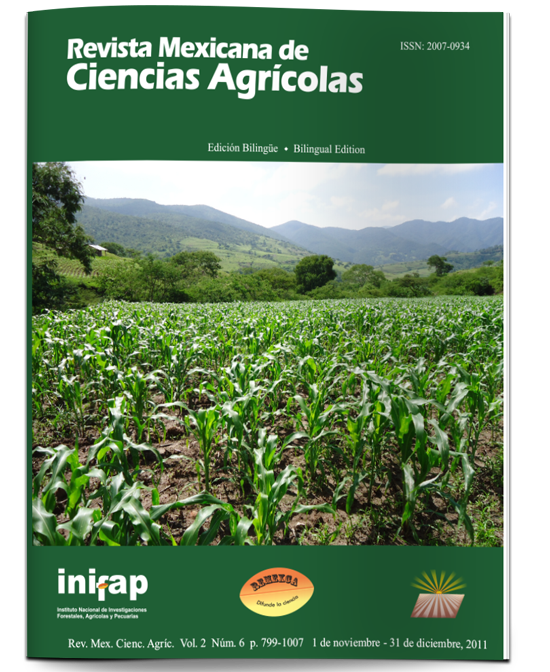RESPONSE OF THREE-WAY CROSS HYBRIDS AND TESTER OF CORN IN THE CENTRAL MEXICAN HIGHLAND
DOI:
https://doi.org/10.29312/remexca.v2i6.1564Keywords:
Zea mays L., ear cob’s production, High Valleys, hybrids of three lines, multivariate methodsAbstract
The identification of hybrids formed with three outstanding lines with germplasm from different research institutions could contribute to increase the heterosis in grain’s yield and the stability of maize planted in the High Valleys of Central Mexico. This work was conducted in 2009 in ten environments of this region with the aim to identifying outstanding genetic material. In an alpha lattice experimental design with two 8∗5 replicates per environment, we evaluated 40 genotypes of maize: early white trilinear 32 hybrids, four single crosses (testers) and four controls from CIMMYT. The most outstanding results indicated the following: a) the environments recorded with a higher production than 9.5 t ha-1 were Tlahuelilpan, Batán (+) and Batán (AC) but, Tlaxcoapan was the one with average stability and yield b) fifteen cob genotypes had statistically similar yields between 8.2 and 9.4 t ha-1, but the nones with the highest production were identified by the codes 21, 28, 27, 29 and 20 (CMS989001//Mexico gpo. 10; CMS 989003//Tuxpeño Cream 1; CMS 989003//SB1; CMS 989003//Mexico gpo. 10; CMS 989001//Tuxpeño Cream 1), with very acceptable arithmetic means in favorable environments and under conditions of low fertility and drought, but unstable, due that, out of these, only genotype 27 was the most stable over the ten contrasting environments. The best testers were identified by codes 35 and 36 [CMS 989 001 (P3) and CMS 989 003 (P4)], both with 9.3 t ha-1. The best trilinear hybrid control was identified with the key 39 and, the origin CMT 089,005, with 8.5 t ha-1. The best control and, the best testing had ear yields statistically identical as the 15 most outstanding hybrids. The subgroput of genotypes composed of the five trilinear hybrid and, the two testers, with the largest ear productions, are the most prominent genetic material for use in a new breeding program, and generate production technology or planting recommendation trade in this region of Mexico.
Downloads
Downloads
Published
How to Cite
Issue
Section
License
The authors who publish in Revista Mexicana de Ciencias Agrícolas accept the following conditions:
In accordance with copyright laws, Revista Mexicana de Ciencias Agrícolas recognizes and respects the authors’ moral right and ownership of property rights which will be transferred to the journal for dissemination in open access. Invariably, all the authors have to sign a letter of transfer of property rights and of originality of the article to Instituto Nacional de Investigaciones Forestales, Agrícolas y Pecuarias (INIFAP) [National Institute of Forestry, Agricultural and Livestock Research]. The author(s) must pay a fee for the reception of articles before proceeding to editorial review.
All the texts published by Revista Mexicana de Ciencias Agrícolas —with no exception— are distributed under a Creative Commons License Attribution-NonCommercial 4.0 International (CC BY-NC 4.0), which allows third parties to use the publication as long as the work’s authorship and its first publication in this journal are mentioned.
The author(s) can enter into independent and additional contractual agreements for the nonexclusive distribution of the version of the article published in Revista Mexicana de Ciencias Agrícolas (for example include it into an institutional repository or publish it in a book) as long as it is clearly and explicitly indicated that the work was published for the first time in Revista Mexicana de Ciencias Agrícolas.
For all the above, the authors shall send the Letter-transfer of Property Rights for the first publication duly filled in and signed by the author(s). This form must be sent as a PDF file to: revista_atm@yahoo.com.mx; cienciasagricola@inifap.gob.mx; remexca2017@gmail.
This work is licensed under a Creative Commons Attribution-Noncommercial 4.0 International license.



